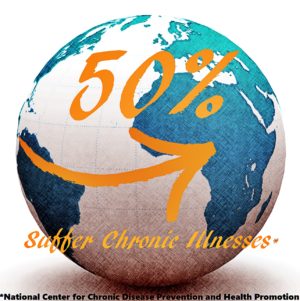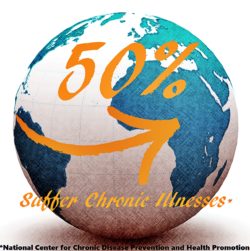
Can Lifestyle Changes Reverse Disease?
December 15, 2016 2:30 pm Leave your thoughtsDepending on the type and origin of the disease, some can be reversed, slowed or prevented all together. It is important to understand the differences between the three and what you can do about it. Thankfully, it is not as complicated as it may seem.
Join us as we take the next few posts to explore the topic that effects half of all adults. If you are not currently dealing with some sort of chronic condition, then someone you know and love likely is. So keep reading and stay with us!
Chronic diseases are illnesses lasting three or more months that normally cannot be prevented by vaccines, cured by medication, or clear up on their own. Chronic diseases are within a body and not communicable. On the other hand, infectious diseases are communicable and can pass person to person. For some the word “disease” is foreboding and hard to discuss. And depending on which generation you grew up in, there may even have a silent sense of shame attached to it. Ever wonder why?
Up until the 1970’s, in addition to malnutrition, the most common causes of death were infectious and parasitic diseases. Conditions for which most people today have received vaccinations such as Cholera, Diphtheria, Measles, Small Pox, Malaria, Polio or TB. Many of the diseases of our past, pre-1970’s, were communicable which is why “disease” earned a sense of dread. It was literally associated with being ‘dirty’, in a sense, as infections were spread through body fluids and lack of proper hygiene awareness.
With the blessed advent of penicillin, vaccinations and public health awareness we have come a long way to  eradicating many infectious diseases that were once deadly threats to our society. Educating through school and community programs and utilizing popular media as spokespersons, we have become more conscientious of the benefits of health and hygiene – we cover our mouths and wash our hands like our mothers taught us to!
eradicating many infectious diseases that were once deadly threats to our society. Educating through school and community programs and utilizing popular media as spokespersons, we have become more conscientious of the benefits of health and hygiene – we cover our mouths and wash our hands like our mothers taught us to!
Post bell bottoms and go-go boots era, we have managed to gain an extra 10 years of life expectancy!(1) Love me some hand sanitizer! So then, why has the topic of “disease” made such a resurgence? Was it always this way? Nope. Just looking back even just 15-20 years ago, the general public did not feel as comfortable and confident to lob out the “d” word as it does today. Have you ever wondered why that is? With the advent of public health awareness via education through school, the dawn of “Google” search engines and advances in medicine the public is more versed in medical conditions then we have ever been historically.
It is a part of regular vernacular and social conversation today, does this scenario sound familiar?
Your best-friends-daughter has just been diagnosed with Celiac Disease and you have to figure out how to make gluten free cupcakes! Your grandpa’s vision is blurry and he has been unusually irritable and tired…could it be diabetes? What about your neighbor who has that terrible cough that plagues her due to COPD? Oh and thank God you had that mole removed, the biopsy came back positive for skin cancer!
Unfortunately, what we have gained by overcoming infectious diseases we have replaced with time spent battling chronic illnesses and injuries. As of 2012, about half of all adults—117 million people—had one or more chronic health conditions. (2) Additionally, half of those battling chronic health illnesses had two or more to content with.(3)
So, what can these extra years here on earth do for us? Perhaps we can start converting these extra years into lessons learned and begin to work at understanding what it will require to gain both quantity AND quality of life. Will we do what it takes to recover quality of life when we can’t merely stand in line for a vaccination to fix the chronic type of diseases we face today?
In the next few blog posts we will discuss chronic diseases and the illnesses many of us face today. We will provide research and information while investigating “why we do what we do” in order to come alongside those who want and need extra support. We want to encourage you to step out and take charge of your own health.
We will be real, informative and hopefully creative. Some of it might surprise you. Come on now, you know we can’t just stay stuck repeating our same old unhealthy habits over and over while expecting different results can we? That’d be crazy! Seriously though, that is how Albert Einstein defined “insanity”!
Thanks for joining with us at Rancho Paseo Medical Group in this series on Diseases, it is our hope that you can look forward to learning along with us! If you have a chronic condition that you would like medical help with, our team at Rancho Paseo Medical Group is ready and eager to come alongside you! If you have any questions, please feel free to comment and we’ll get back to you. As always, please don’t hesitate to call our office at PH: 951.769.0079.
Don’t forget to connect with us on Facebook, Twitter and Google!
1 National Center for Health Statistics, National Vital Statistics Reports. Web: www.cdc.gov/nchs.
2 Ibid
3 Ward BW, Schiller JS, Goodman RA. Multiple chronic conditions among US adults: a 2012 update. Prev Chronic Dis. 2014;11:130389. DOI: http://dx.doi.org/10.5888/pcd11.130389.
Tags: Chronic Disease, Healthy Lifestyle, lifestyle medicine, quality of life, Reverse Disease
Categorised in: Lifestyle Medicine
This post was written by NE Rancho Paseo Medical Group


